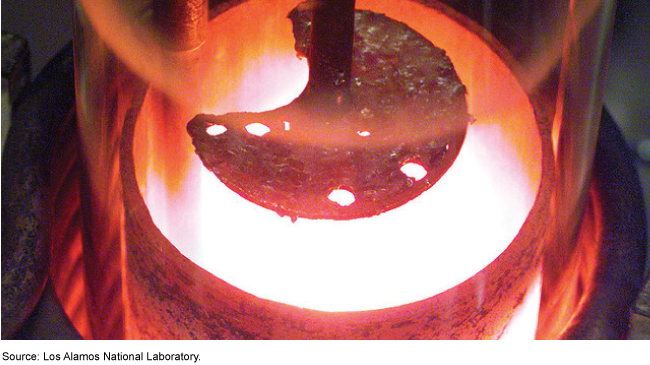Nuclear Weapons: Information on the National Nuclear Security Administration's Research Plan for Plutonium and Pit Aging
Fast Facts
A plutonium pit is the central core of a nuclear weapon—the part that triggers the explosion. All the weapons in the nation's nuclear stockpile contain them. But most of the plutonium pits in the stockpile are at least 30 years old. Radioactive decay can affect the performance of these pits as they age.
The National Nuclear Security Administration is responsible for the stockpile's performance, safety, and reliability. In 2021, the NNSA developed a comprehensive 10-year research plan to study the effects of plutonium aging.
The research will help NNSA better predict how long the pits will be effective for each weapon system in the stockpile.
Molten plutonium being forged at Los Alamos National Laboratory

Highlights
What GAO Found
This report provides an unclassified summary of GAO's classified briefing to the House of Representatives' Committee on Armed Services. In 2021, the National Nuclear Security Administration (NNSA) developed a 10-year research program plan to study plutonium and pit aging. According to NNSA officials, the results from the research plan will allow NNSA to more confidently predict pit lifetimes for each nuclear weapon system in the U.S. stockpile. To do so, NNSA requires the use of experimental facilities across the nuclear security enterprise. NNSA will also need to expand its inventory of samples of artificially aged plutonium so that aging effects can be projected decades into the future. NNSA's estimated budgetary requirements to carry out the planned experiments, modeling, and simulation activities total about $1 billion over the 10-year period of fiscal years 2021 through 2030.
Why GAO Did This Study
NNSA is responsible for ensuring the stockpile's performance, safety, and reliability. Scientists and other weapons experts have identified concerns that radioactive decay of plutonium in a pit, called aging, over many years may degrade a weapon's performance. Prior to 2021, independent evaluations indicated that NNSA was not sufficiently prioritizing plutonium and pit aging research. The results of this research are needed to inform decisions about stockpile management and modernization.
For more information, contact Allison Bawden at (202) 512-3841 or bawdena@gao.gov.
